I kind of wanted to make curry, and I kind of wanted to make chili. I had excellent coconut milk from the Asian market - the boxed kind, and yes the canned kind is fine, but also yes, the boxed kind is better - and neither chili con carne seasoning nor enough curry powder for a full batch of curry. It's the time of year when my spices all run out at once except for like, cake spice and savory.
So this is basically chili, in that it's made with ground beef and beans and peppers and it's spicy, and kind of curry in that it has coconut milk, but the seasoning blend is actually more of a North African flavor profile, because that's what I had in the house. It really works, though. We had it with rice, usually with chopped scallions on top. I'd avoid the other usual chili accompaniments, though cilantro might work. Naan or pita might work instead of rice, too.
1 1/2 pounds ground beef, browned, fat drained. Even if you don't usually drain the fat for chili, I would do so here because of the coconut milk.
3 red bell peppers and a handful of fresh chiles of your choice (or sub in dried chiles later), diced
3 medium onions, diced
2 tablespoons coconut fat or reserved fat from the ground beef
1 can of beans of your choice, or equivalent of dried and cooked (I used vallarta beans)
500 ml coconut milk
Spices, in order, to taste: generous amounts of cumin, black pepper, coriander; notably smaller amounts of cinnamon, cardamom, paprika, clove
Salt to taste.
Real real simple: brown and drain the ground beef. Saute the onion and pepper in the coconut fat until soft. Add the ground beef back, along with the beans, coconut milk, spices, and salt. Simmer covered for half an hour to meld everything, and uncovered until the coconut milk cooks down and the chili is thick.
Adjust salt and heat level to taste - the coconut milk will take a lot of spice, so feel free to add a few squirts of sriracha.
Monday, October 20, 2014
Wednesday, August 20, 2014
these are the groceries in my neighborhood

The first Whole Foods in the state is opening right in your town, Bill, I told myself, right in a spot you drive by twice a day bringing Caitlin to the bus station to go to work! As a food blogger, you need to get out there, and you need to cover this.
And I did, and I will. But I want to put it in context first. So this is, simply, an introduction to shopping for food where I live.
The area
I live in Nashua, New Hampshire, a small city despite being the second-largest in northern New England. Nashua's along the southern edge of the state, closer to Boston than it is to the lakes and mountains. There are significant cultural and economic differences between southern and northern New Hampshire, which although relevant here - it's why Nashua got a Whole Foods, not Laconia, and why if Laconia ever does get one, it'll be for the sake of the summer tourists - are beyond the scope of an afternoon blog post. But those differences and the histories behind them touch on every aspect of everything I talk about here. The area is as suburban as it is because* a federal program allowed dairy farmers to cash out at the same time that the last years of the Cold War were fueling the defense and tech industries that set up shop here - Sanders, Lockheed, Raytheon, Wang, Digital, they all employed my friends and neighbors when I was a kid, even while parts of the area (like Hollis, next to Nashua, where I was raised) were still rural enough that traffic stopped to let the cows cross a couple times a day, and we all went uptown to watch the first traffic light do its thing.
(*In part. The process had started before that, and I don't myself know all the factors - New England history is hardly my specialty. But the farm buyout played a major role in continuing and accelerating that process by making land available for developers right at the time that demand for land happened to be high. The student population of the high school in Hollis, for instance, is about 225% as high as it was when I graduated in 1993.)
New Hampshire bobs up and down alongside a couple of other states which like swimmers with a beach ball pass along the title of Whitest State In The Country every couple years. That whiteness is least pronounced in southern New Hampshire, where the Indian population is growing and we are proximate to the large Cambodian population of Lowell, Massachusetts, but when I say "least pronounced," understand that we are comparing ivory and eggshell.
New Hampshire isn't Boston. Boston is culturally distinct from New England as a whole the same way Atlanta's distinct from rural Georgia. But a lot of people in southern New Hampshire certainly depend on Boston, either for work - Caitlin's commute is about an hour and a half, worse in bad traffic - or shopping, and the economy of New Hampshire is heavily dependent on Massachusetts in myriad ways: Massholes shop here because New Hampshire doesn't have sales tax, they move here because it doesn't have income tax and the taxation-to-performance-on-arbitrary-metric-indicating-quality-of-education ratio is historically quite good, they buy cigarettes and liquor here because the state taxes on those are so much lower than Mass's. New Hampshire mocks Massachusetts' taxes, and politicians in NH are derided if their policies seem "more appropriate to Massachusetts," but if Mass taxes WEREN'T so high, New Hampshire would be in a heap of financial trouble.
That too affects the shopping, of course. This Whole Foods, for instance, will draw a lot of northern Massholes up.
No offense about the Masshole thing. It's just the term of art.
So much has changed here since I was a kid, partly due to the prevalence of transplants in southern New Hampshire, and now of the second and third generations of early transplants. The New England palate is pretty timid. You never would have seen sriracha on the shelf when I was a kid, you know? Okay, that was true in most of the country, and that's the thing, I spent my twenties outside of New England, so some of what's changed is just about what's changed in the country as a whole. I don't know if it's because of local or national change that you can get ground buffalo at basically every supermarket here now, for instance, or fish sauce, or persimmons. I just know that I started cooking young enough that you definitely couldn't get that stuff when I lived here the first time round.
So a Whole Foods is a big change, but at the same time, not as big a change as it would have been 25 years ago, or even 10 years ago. The region has been primed for it.
Now if they would just open a Bruegger's here. (All the NH Bruegger's closed before I moved back, and all the NH-based bagel places I've tried have been ... not great, Bob.)
The farmstands
There are a number of farmstands in the area, but I mostly frequent three, all of which are either very close to my condo or up the street from my mother's house in Hollis.
* Lull Farm
I get that it's called Lull Farm, but it's been "Lull's" to me all my life. Lull's is in Hollis, which like I said is the former-farm-town-turned-expensive-housing-development in which I was raised, and where my mother and brother still live. Lull's has gradually expanded in the years that I've been here, including at one point a major renovation that added air conditioning, doubled the cooler space, and added a whoooole lottt of non-farmstand goods. They grow a lot of their own produce, don't get me wrong, but in addition to carrying not-local-and-never-could-be produce like lemons and pomegranates, they've got your Kettle chips, your pretzels, your sodas, your fancy gourmet sauces and mustards (it's where I buy Edmond Fallot mustards), and the most recent addition, a cheese counter.
Lull's always carries things I can't find elsewhere, whether the cheese - though Whole Foods will challenge that - or various apple and potato varieties. They're the only place I know around here to grow callaloo greens.
They're also crowded as shit. This has become more and more true - I suppose the expansion is particularly appealing to people who are driving up from Massachusetts, because the more they can buy, the more worthwhile the drive seems. I used to get around this by going early, an advantage of working at home. Unfortunately, for the last couple years, I have found that if I go in the early morning when I used to, they haven't actually finished putting the produce out, which is especially aggravating at key times of the year when I'm waiting to see if, say, the blueberries or the strawberries are in yet. Quality of service varies a LOT - a lot of the cashiers not only don't know much about what they're selling, but don't keep an eye on the register, which sits unmanned in less busy times.
In addition to their own produce, other local goods include locally made pasta and pasta sauce, locally raised meat, New England cheeses, and local raw milk.
Lull's apple cider is the best around, for my money.
* Brookdale's
Damn near next door to Lull's is Brookdale's, a smaller farmstand serving a farm that does most of its business wholesale. Smaller selection than Lull's, both of local stuff and of the gourmet what's-its and who's-its they offer, but worth checking out periodically.
* Kimball's
Not to be confused with Kimball Farms, an ice cream stand, Kimball Fruit Farm in Pepperell, Massachusetts, is smack on the NH/Mass line across from Hollis, and halfway between my mother's house and my favorite ice cream stand. They also sell produce at various Boston area farmers markets.
Smaller than either Lull's or Brookdale's, Kimball's is in many ways my favorite farmstand. They grow a lot of things other farms don't: sour cherries, fantastic grapes, broccoli raab, and in the past I'm pretty sure we got fava beans there. The heirloom apple selection is terrific, and they sell crabapples, including some that are just sweet enough to eat out of hand.
This is the benefit to living in New England, you know? Being able to get the good apples.
The grocery stores
* Hannaford
The nearest store to me, Hannaford is based in Maine, and is the second-largest supermarket chain in New England. Maybe because of that, it gets a bad rap from a lot of people. This is the only location I'm familiar with, and I've always loved it. The fish and meat are both better at Harvest Market, while Market Basket has more variety of both, but this is where I find most of what I need, usually at a good price.
Hannaford is currently in the middle of an expansion, and the store is total havoc - which is exacerbated by the Market Basket situation.
* Market Basket
Market Basket has been invaluable to me as a source of lesser known cuts of meat -- pig tails, pork belly -- and Latin and Asian produce. For a while they also carried Sun Drop, though for some reason the location nearest me has stopped doing that.
Market Basket's been in the news a lot lately - it's the only thing people talk about as much as the weather. I couldn't begin to summarize everything myself; suffice to stay, I stand with Arthur T., and haven't been shopping there. It's been impressive seeing such a large labor action, and it's been clear how big an impact Market Basket has had on the culture of Massachusetts and New Hampshire. What that Wikipedia article leaves out is how many Market Baskets were historically opened in what we would now call food deserts, offering a win-win situation: working class families could get cheaper groceries than the corner store vultures offered, while Market Basket was able to operate in places their competitors had neglected. The economic toll of the current situation on MB customer families has been significant.
* Harvest Market
There is a small Harvest Market in Hollis. More expensive than the other two stores, with somewhat erratic pricing - I was shocked to find out, post-checkout, that a bottle of Angostura bitters had cost me something like fifteen dollars. Not everything is expensive, or even over-priced - you just have to pay attention to what you're buying. The produce selection is negligible: purely utilitarian, grab a few things so you don't need to go to Nashua. The meat selection is small but the quality is good - best supermarket ground beef of any of these stores, often quite good steaks and lamb chops, and one of the few local carriers of Smart Chicken. (MB carries Bell and Evans' air-chilled chicken, though.)
Harvest has a handful of things I can't find elsewhere - for a while, it was the only place I could find Louisiana hot sauce, for instance, and I've often found goat butter there.
* Wal-Mart
Yes, I have issues with Wal-Mart too. But they are the only store that carries, for instance, canned field peas, frozen black-eyed peas, and lamb belly. Until recently they were the only place I could find Valentina hot sauce, but Hannaford carries it now (along with frozen okra, which I also had to get at WM in the past).
* Lanna Asian Market
Our main local Asian market, Lanna has a lot of Filipino goods, as well as Southeast Asian, Chinese, and Japanese items. No fresh meat or seafood, but the fresh produce includes various greens and herbs, daikon, and green papaya.
Staples from here for me include coconut milk (boxed when I remember to buy it), Indonesian ramen, green papaya, Korean rice cakes, and of course various soy sauces.
* Trader Joe's
As I recently patiently explained to an internet troll, Trader Joe's (Trader Joe's's's's's) business model is weird but nevertheless clear. They don't compete with your regular supermarket. Unless some TJ's are significantly different from the seven or eight locations I've been to, you could never meet all your grocery needs there - there are too many basics they don't carry, and many many more categories where they only carry one or two items, usually their store brand. You're not gonna get Coca-Cola, Kool Aid packets, paper towels, and pickles there. Half of your shopping list is probably not on the shelf.
So how do they get you in? By selling what they sell. Same as with an Asian market, a Russian market, a Latino market. You don't go there to get everything. You go there for what they have.
What they have is determined by their weird but effective method of only stocking the bestsellers. Something stops selling like hotcakes, they stop carrying it. New stuff comes and goes all the time, even beloved things, because they're not beloved enough. This is basically the selling point, because the cult of TJ's revolves around trying all this new shit. That's also why you hear so much about their snack foods - people may go in for cutlets and grapes, but they're gonna get the triple ginger cookies, the cookie butter ice cream, the peanut butter filled pretzels.
Because they only sell bestsellers, prices are relatively low. I'm always surprised by how little I spend there, even when I'm stocking up. Their Salsa Autentica, for instance, is a staple for me, but it's only two dollars a jar. Their frozen croissants are fucking brilliant, especially the almond ones, and the cheese selection usually includes a few fantastic bargains (Five-Year Cheddar was a recent one).
*** Whole Foods!
Okay, there's your context! There's your status quo.
They've been talking about a Whole Foods for most of the eight years since I moved back to New Hampshire. They took ages to pick a location once they finally announced Nashua as an official location, and I've lost track of how long this location was under construction. It's opened in the same location as a former Market Basket, though they rebuilt the whole plaza (and relocated my childhood Papa Gino's in the process).
I just said "location" way too much, but I need to wrap this post up eventually.
Whole Foods isn't Trader Joe's. It will not save you money. If you do your regular shopping there, you're gonna feel it. On the other hand, it doesn't have to cost an arm and a leg, either, and I was surprised how many good deals I saw today - San Pellegrino sodas at $3 for a six-pack, for instance, which is half the price I often see them at, and possibly the least I have ever spent on them since moving here. There were a lot of good deals under the 365 house brand, too - I put another brand of tangerine juice back when I realized a half gallon of 365 tangerine juice was less than twice the price of a single serving of the other brand. Can't speak to relative quality having only bought the one, but even so.
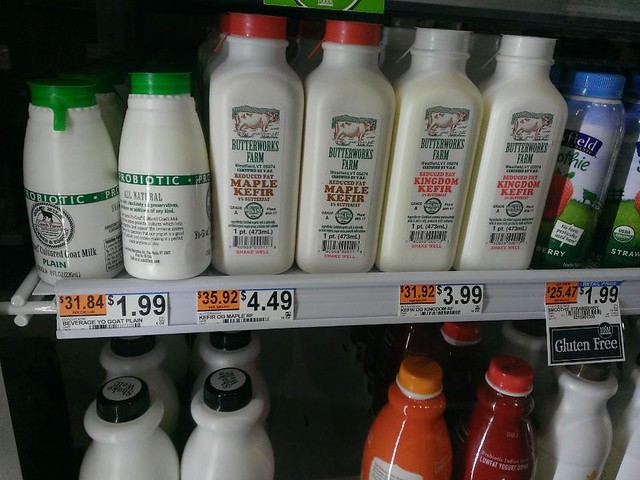
The quality at Whole Foods is high, but there is a definite audience they have in mind. For instance, I noticed probiotic foods are very popular with this presumably health-minded demographic, and there were a lot of probiotic drinks, yogurts, and yogurt drinks ... but either I missed any kimchi, one of the original probiotic foods, or they just didn't carry enough kinds of it for it to be noticeable.
But they have two different brands of the Icelandic yogurt skyr, you know? Two skyrs! Multiple flavors! So this is going to be an interesting adjunct to my shopping, for sure.
I didn't do a big shop, but tried to take some photos to capture some highlights.
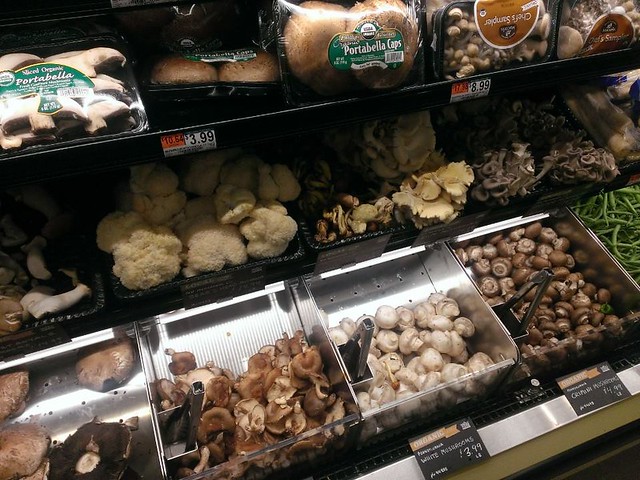
Mushrooms! Many kinds of bulk mushrooms, including several - bear's head, notably - that I have not seen before.

The fish counter didn't really have anything unusual, but the butcher had some nice things, including pork belly and Irish-style bangers.
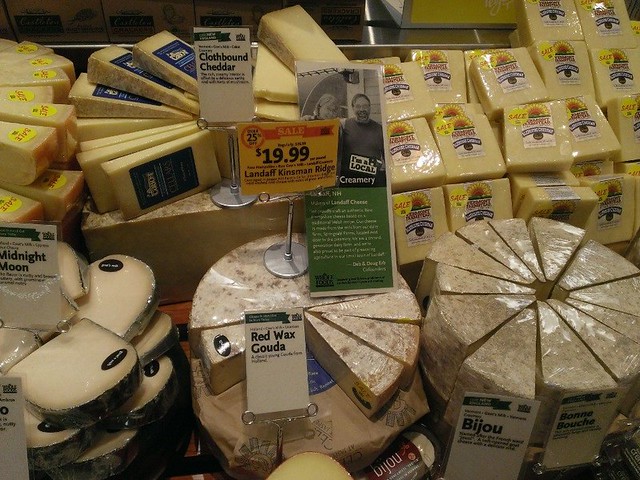
Similarly, not a lot at the cheese counter that I haven't seen before, though a lot of it is stuff I don't find at other New Hampshire supermarkets. Kinsman Ridge, Caitlin's favorite cheese, was the current sale cheese, which is a good sign.
Yesterday was the Grand Opening, and it was PACKED from what I hear - even when I passed by last night around eight, the parking lot was dense with cars. This morning was not bad at all. I imagine this weekend - when everyone who hasn't been able to go to Market Basket suddenly has another option, albeit a much less affordable one - will be a madhouse.
Saturday, August 9, 2014
farmstands 8-9-14
A farmstand report with a little more meat!
I stopped at Lulls ostensibly for cheese and wild blueberries, but the local melon is in, corn is going strong, heirloom tomatoes are getting going, peaches and nectarines were strong. There was a lot of non-local produce too - strawberries, Thomcord grapes (a first - I've only seen them at Trader Joes before), New York state sour cherries, champagne grapes.
David, the owner and operator, was there and making conversation, so I asked him why they don't grow black raspberries anymore. At Kimballs they don't grow black raspberries because demand is insufficient. David had a different answer for Lulls: pests.
According to Dave, there's a new fruit fly in the United States that first arrived in New England 3-4 years ago and is especially aggressive, and it's changed pest management for berries. Since raspberries are soft, pest management is the hardest for them - "they go bad so quickly anyway that there was always a lot of loss of product" (we had just been talking about loss of product in a lengthy conversation about melon farming, because of the difficulty of knowing when they're perfectly ripe, especially when you grow ten different varieties). "So many of the New England grown raspberries you buy are riddled with maggots from the fruit flies," David said. "You have to spray all the time to keep them away. We just don't grow them anymore. I planted flowers where the raspberries used to be." The raspberries sold at Lulls come from Driscoll instead, in Mass.
So that explains not only why I haven't seen black raspberries in a few years, but golden raspberries either, and I just hadn't noticed that the red raspberries at Lulls weren't even their own.
I stopped at Lulls ostensibly for cheese and wild blueberries, but the local melon is in, corn is going strong, heirloom tomatoes are getting going, peaches and nectarines were strong. There was a lot of non-local produce too - strawberries, Thomcord grapes (a first - I've only seen them at Trader Joes before), New York state sour cherries, champagne grapes.
David, the owner and operator, was there and making conversation, so I asked him why they don't grow black raspberries anymore. At Kimballs they don't grow black raspberries because demand is insufficient. David had a different answer for Lulls: pests.
According to Dave, there's a new fruit fly in the United States that first arrived in New England 3-4 years ago and is especially aggressive, and it's changed pest management for berries. Since raspberries are soft, pest management is the hardest for them - "they go bad so quickly anyway that there was always a lot of loss of product" (we had just been talking about loss of product in a lengthy conversation about melon farming, because of the difficulty of knowing when they're perfectly ripe, especially when you grow ten different varieties). "So many of the New England grown raspberries you buy are riddled with maggots from the fruit flies," David said. "You have to spray all the time to keep them away. We just don't grow them anymore. I planted flowers where the raspberries used to be." The raspberries sold at Lulls come from Driscoll instead, in Mass.
So that explains not only why I haven't seen black raspberries in a few years, but golden raspberries either, and I just hadn't noticed that the red raspberries at Lulls weren't even their own.
Monday, August 4, 2014
farmstand 8-2-14
Here at last: Plums! (For the last week.) Sour cherries! Tomatoes! Wild blackberries!
Still to come: Grapes, wild blueberries, early apples like Gravensteins and Jersey Macs.
Caitlin brought some chicken of the woods and black trumpet mushrooms home from the Copley Farmers Market. Chicken of the woods is a large orangish-brownish-yellowish mushroom that, like hen of the woods or maitake, can taste a lot like chicken when it's cooked - and as we discovered, it's a lot more chickeny than hen of the woods, losing very little volume when sauteed and having a firm meaty texture.
Last night we had tacos of a sort -
Potato flatbread for the tortillas: mashed potatoes mixed with flour, salt, and a dash of baking powder until it was the texture of a dough that could be rolled out (I'm not providing proportions because it just depends on how wet your potatoes are), cooked for 90-120 seconds per side.
Filling: chicken of the woods and black trumpet mushrooms sauteed with smoked olive oil, cumin, chard, and scallions, and salt. (Particularly with the chard, you don't want to skimp on the salt.)
Salsa: finely diced carbon tomato, cucumber, scallion, serrano pepper, lemon juice, salt.
Of course, this fairly healthy meal was partly to off-set the chicken-fried meatloaf of a few nights ago:

Chicken-fried meatloaf is exactly what it sounds like: I made a meatloaf (making sure not to skimp on the filler, because it should be firm), chilled it, sliced it, dipped the slices in seasoned flour, then egg and milk, then seasoned flour again, and pan-fried them until crispy. The gravy is made from the drippings of the meatloaf, flour, and milk.
Still to come: Grapes, wild blueberries, early apples like Gravensteins and Jersey Macs.
Caitlin brought some chicken of the woods and black trumpet mushrooms home from the Copley Farmers Market. Chicken of the woods is a large orangish-brownish-yellowish mushroom that, like hen of the woods or maitake, can taste a lot like chicken when it's cooked - and as we discovered, it's a lot more chickeny than hen of the woods, losing very little volume when sauteed and having a firm meaty texture.
Last night we had tacos of a sort -
Potato flatbread for the tortillas: mashed potatoes mixed with flour, salt, and a dash of baking powder until it was the texture of a dough that could be rolled out (I'm not providing proportions because it just depends on how wet your potatoes are), cooked for 90-120 seconds per side.
Filling: chicken of the woods and black trumpet mushrooms sauteed with smoked olive oil, cumin, chard, and scallions, and salt. (Particularly with the chard, you don't want to skimp on the salt.)
Salsa: finely diced carbon tomato, cucumber, scallion, serrano pepper, lemon juice, salt.
Of course, this fairly healthy meal was partly to off-set the chicken-fried meatloaf of a few nights ago:

Chicken-fried meatloaf is exactly what it sounds like: I made a meatloaf (making sure not to skimp on the filler, because it should be firm), chilled it, sliced it, dipped the slices in seasoned flour, then egg and milk, then seasoned flour again, and pan-fried them until crispy. The gravy is made from the drippings of the meatloaf, flour, and milk.
Wednesday, July 23, 2014
farmstands 7-23
The first of the local corn and peaches are in!
Still available: raspberries, domesticated blueberries, squash and brassicas, potatoes, onions, carrots, radishes.
Not yet: non-hothouse tomatoes, sour cherries, blackberries (not sure who's selling them these days), non-red raspberries (likewise), other berries, grapes, apricots, plums.
Gone: strawberries, sweet cherries, lettuce (not sure I ever saw it this year). Green garlic looks like it's all dry now, garlic scapes seem to be gone.
Some kind of cooking post soon.
Still available: raspberries, domesticated blueberries, squash and brassicas, potatoes, onions, carrots, radishes.
Not yet: non-hothouse tomatoes, sour cherries, blackberries (not sure who's selling them these days), non-red raspberries (likewise), other berries, grapes, apricots, plums.
Gone: strawberries, sweet cherries, lettuce (not sure I ever saw it this year). Green garlic looks like it's all dry now, garlic scapes seem to be gone.
Some kind of cooking post soon.
Monday, July 7, 2014
papaya salad
Papaya salad might be my favorite dish in the world.
Maybe I'm hedging by saying "dish," so that sour cherries, fresh tomatoes, or whiskey can still be my favorite food, I don't know. But I'm telling you, papaya salad is way up there.
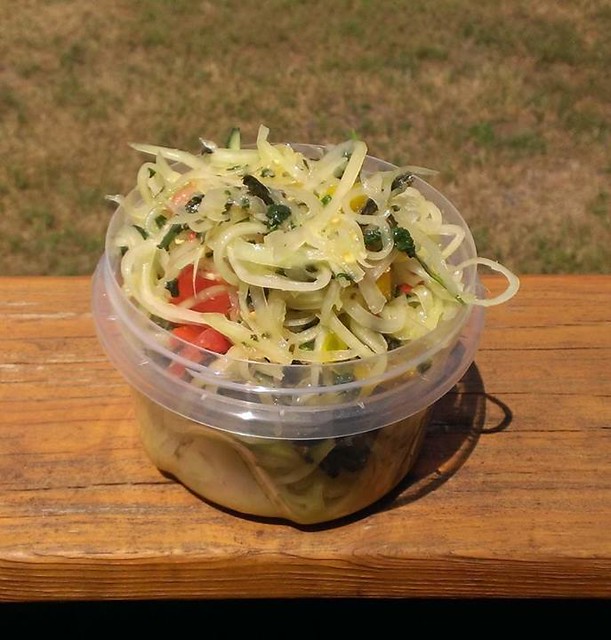
If you haven't had it, both "papaya" and "salad" are a little misleading. It's almost like a coleslaw, and feel free to use it as one. The papaya used for it is green - unripe - and shredded before being pounded in a mortar and pestle with lime juice, fish sauce or other source of salt (plain salt or soy sauce is fine to keep it vegan), fresh herbs and seasonings, and often some other vegetables - blanched long beans are common, as are tomatoes and raw Thai eggplant. I tend to use just papaya and tomato for the vegetables - I want the papaya to provide all the texture.
Papaya salad comes from Southeast Asia - it's often on Thai restaurant menus, and is called som tam in Thailand - and is perfect hot-weather food, but like I said, don't feel you have to limit it to other Southeast Asian contexts. Have it on a hot dog. Have it with some boiled crawfish or shrimp. Have it with fried chicken or fish.
This is more about technique than recipe. The two key things are, of course, shredding and pounding the papaya. Well, and finding green papaya in the first place. An Asian market is your best bet, though the Market Basket here in suburban New Hampshire carries it now, so who knows. You may be able to find it already shredded - I used to be able to. If you can't, you can use a mandoline or a very sharp knife, but I tell you what, I am in love with the Kom Kom miracle knife:

The Kom Kom works like a peeler - you pull it across the fruit (after you've peeled it, unlike the above photo) and instead of cutting away a layer of peel, it cuts thin julienned strips. Check it out:
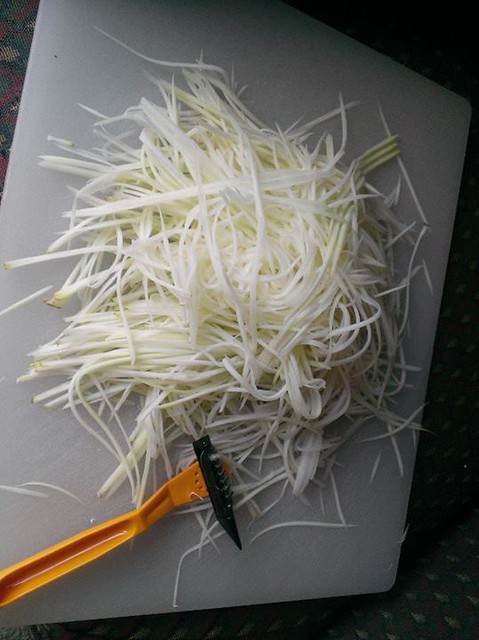
It took me a few years of occasionally trying to make papaya salad to realize that you really HAVE to pound it. You can't just toss the shredded papaya with the seasonings. Pounding it tenderizes the unripe fruit and lets the seasonings seep in. You'd be surprised how hard you can pound it without mashing it.
Ideally you want to pound it in a Lao-style clay mortar, the important aspect of which is that it has a narrow bottom and high sides, which is perfect for this. I know it sounds like I'm saying you need a lot of special equipment. And maybe you do! But a regular mortar and pestle will work too, just not as easily.

This is less than half of the shredded papaya in the mortar. It'll shrink down a lot once pounded:
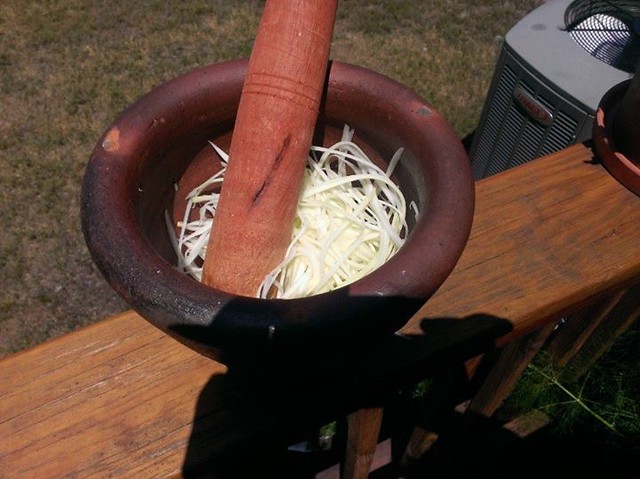
So everything about this is "to taste," but you want:
Fresh lime juice;
Fish sauce or other salt (salt, soy sauce, shrimp paste, crab paste, mud crabs);
Chile (I used a small red Thai chile);
Fresh herbs (mint, cilantro, culantro, and/or any basil - I also used sorrel this time, and was out of mint);
Other seasonings that appeal to you - I use ginger and lemongrass, garlic is common;
A little sugar;
Other vegetables if you like. I add a few cherry tomatoes. Parts of Thailand also add peanuts.
Pound the ingredients together, making sure the herbs are good and bruised, everything but the papaya (and long beans if you're using them) is pulverized, and the papaya is tenderized. There's a technique that this mortar lends itself naturally to of tossing the papaya a little with the pestle and then banging it against the side as it falls. Soon enough:
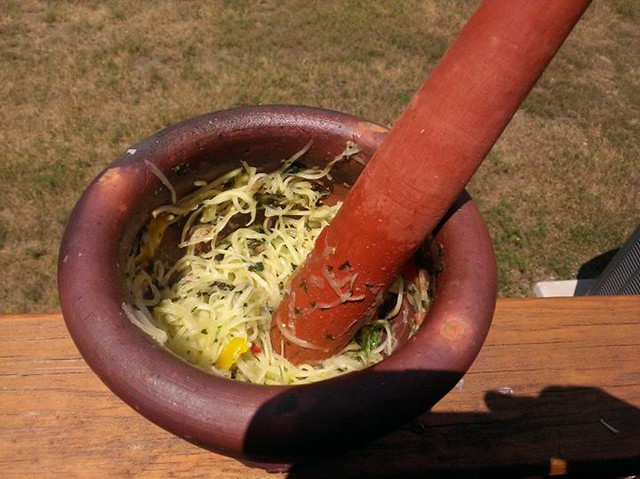
Tada.
You want the flavors balanced - a little tart, a little sweet, very green and herbal, a bit spicy (sometimes very spicy).
Maybe I'm hedging by saying "dish," so that sour cherries, fresh tomatoes, or whiskey can still be my favorite food, I don't know. But I'm telling you, papaya salad is way up there.

If you haven't had it, both "papaya" and "salad" are a little misleading. It's almost like a coleslaw, and feel free to use it as one. The papaya used for it is green - unripe - and shredded before being pounded in a mortar and pestle with lime juice, fish sauce or other source of salt (plain salt or soy sauce is fine to keep it vegan), fresh herbs and seasonings, and often some other vegetables - blanched long beans are common, as are tomatoes and raw Thai eggplant. I tend to use just papaya and tomato for the vegetables - I want the papaya to provide all the texture.
Papaya salad comes from Southeast Asia - it's often on Thai restaurant menus, and is called som tam in Thailand - and is perfect hot-weather food, but like I said, don't feel you have to limit it to other Southeast Asian contexts. Have it on a hot dog. Have it with some boiled crawfish or shrimp. Have it with fried chicken or fish.
This is more about technique than recipe. The two key things are, of course, shredding and pounding the papaya. Well, and finding green papaya in the first place. An Asian market is your best bet, though the Market Basket here in suburban New Hampshire carries it now, so who knows. You may be able to find it already shredded - I used to be able to. If you can't, you can use a mandoline or a very sharp knife, but I tell you what, I am in love with the Kom Kom miracle knife:

The Kom Kom works like a peeler - you pull it across the fruit (after you've peeled it, unlike the above photo) and instead of cutting away a layer of peel, it cuts thin julienned strips. Check it out:

It took me a few years of occasionally trying to make papaya salad to realize that you really HAVE to pound it. You can't just toss the shredded papaya with the seasonings. Pounding it tenderizes the unripe fruit and lets the seasonings seep in. You'd be surprised how hard you can pound it without mashing it.
Ideally you want to pound it in a Lao-style clay mortar, the important aspect of which is that it has a narrow bottom and high sides, which is perfect for this. I know it sounds like I'm saying you need a lot of special equipment. And maybe you do! But a regular mortar and pestle will work too, just not as easily.

This is less than half of the shredded papaya in the mortar. It'll shrink down a lot once pounded:

So everything about this is "to taste," but you want:
Fresh lime juice;
Fish sauce or other salt (salt, soy sauce, shrimp paste, crab paste, mud crabs);
Chile (I used a small red Thai chile);
Fresh herbs (mint, cilantro, culantro, and/or any basil - I also used sorrel this time, and was out of mint);
Other seasonings that appeal to you - I use ginger and lemongrass, garlic is common;
A little sugar;
Other vegetables if you like. I add a few cherry tomatoes. Parts of Thailand also add peanuts.
Pound the ingredients together, making sure the herbs are good and bruised, everything but the papaya (and long beans if you're using them) is pulverized, and the papaya is tenderized. There's a technique that this mortar lends itself naturally to of tossing the papaya a little with the pestle and then banging it against the side as it falls. Soon enough:

Tada.
You want the flavors balanced - a little tart, a little sweet, very green and herbal, a bit spicy (sometimes very spicy).
Wednesday, July 2, 2014
farmstands 7-2
Not much new to report except that local sweet cherries (Bings or close relatives) have been available for a few days and are very good this year. No raspberries or blueberries yet, though I expect them to be early.
Out in the garden, the fennel is getting crazy tall but the bulbs are still thumb-sized. I don't know if this means that, like with celery, fennel grows taller and bushier than you would guess from what you see in the supermarket, or if at some point the plant stops putting energy into growing stalks and starts putting it into developing the bulb.
Out in the garden, the fennel is getting crazy tall but the bulbs are still thumb-sized. I don't know if this means that, like with celery, fennel grows taller and bushier than you would guess from what you see in the supermarket, or if at some point the plant stops putting energy into growing stalks and starts putting it into developing the bulb.
Wednesday, June 18, 2014
farmstands 6-18-14
Just went to Kimballs for strawberries (3.50/small box), and they also had:
Garlic scapes (5.99/lb)
Green garlic, green onions (young onions), and scallions (1.99/bunch)
Heirloom tomatoes and cherry tomatoes ($4/box, obviously hothouse)
Diva cucumbers (2.99/lb, hothouse?)
Various greens (1.99/bunch) - no broccoli raab in evidence this time, probably just sold out
Rhubarb (2.49/lb)
Got a little of everything for $24, half of which was strawberries.
Garlic scapes (5.99/lb)
Green garlic, green onions (young onions), and scallions (1.99/bunch)
Heirloom tomatoes and cherry tomatoes ($4/box, obviously hothouse)
Diva cucumbers (2.99/lb, hothouse?)
Various greens (1.99/bunch) - no broccoli raab in evidence this time, probably just sold out
Rhubarb (2.49/lb)
Got a little of everything for $24, half of which was strawberries.
miti cana de oveja
I'll get a photo when I do a larger multi-cheese post, but I wanted to post about Miti Cana de Oveja, a Spanish cheese from Lorenzo Abellan. This is a fantastic cheese.
This week I made my annual birthday-celebratory shopping trip to Wegmans, returning with about a dozen different cheeses, most of them new to me (in addition to fresh wild halibut, flounder, grey sole, and monkfish; dry-aged steaks; MezzoMix soda from Germany; Kinder chocolates; Hartmann hot dogs; and Vegemite). We tried three of the cheeses last night - all three were fantastic, and all three will be blogged about.
But Cana de Oveja (I see it written without the "Miti" more than with, when I googled for information about the cheesemaker) is something of a Holy Grail cheese for me. For a long time, I've wanted to find "a sheep cheese that's like a goat cheese," meaning a young soft sheep's milk cheese that was like the sheep's milk equivalent of chevre. It's surprisingly hard to find, and I don't know enough about making cheese from sheep's milk to guess why. Sometimes traditions are just traditions - you probably could make mozzarella from goat's milk instead of cow's or water buffalo's, for instance, but you don't because those aren't the farmers who first made it.
Anyway, this is my cheese. This is the cheese I've been looking for! It looks exactly like a bucheron - a bloomy-rinded log with a thin brie-like layer surrounding the chalky white core - and it is so, so good. It's tangy, it's milky, and above all, it's sheepy. "Sheepiness" is a milder thing that "goatiness," but it's its own thing too - it's not "goaty, but less so," it's sheepy, and that's exactly why I've been searching for a cheese like this.
Instant favorite. Probably the best non-American young cheese I've had. I'm looking forward to trying it with some fruit or honey. Caitlin liked the richer, less tangy Castelbelbo, a mixed-milk from Italy, more than this, so perhaps I'll construct our cheese plates accordingly in order to sneak the lion's share of this stuff for myself.
This week I made my annual birthday-celebratory shopping trip to Wegmans, returning with about a dozen different cheeses, most of them new to me (in addition to fresh wild halibut, flounder, grey sole, and monkfish; dry-aged steaks; MezzoMix soda from Germany; Kinder chocolates; Hartmann hot dogs; and Vegemite). We tried three of the cheeses last night - all three were fantastic, and all three will be blogged about.
But Cana de Oveja (I see it written without the "Miti" more than with, when I googled for information about the cheesemaker) is something of a Holy Grail cheese for me. For a long time, I've wanted to find "a sheep cheese that's like a goat cheese," meaning a young soft sheep's milk cheese that was like the sheep's milk equivalent of chevre. It's surprisingly hard to find, and I don't know enough about making cheese from sheep's milk to guess why. Sometimes traditions are just traditions - you probably could make mozzarella from goat's milk instead of cow's or water buffalo's, for instance, but you don't because those aren't the farmers who first made it.
Anyway, this is my cheese. This is the cheese I've been looking for! It looks exactly like a bucheron - a bloomy-rinded log with a thin brie-like layer surrounding the chalky white core - and it is so, so good. It's tangy, it's milky, and above all, it's sheepy. "Sheepiness" is a milder thing that "goatiness," but it's its own thing too - it's not "goaty, but less so," it's sheepy, and that's exactly why I've been searching for a cheese like this.
Instant favorite. Probably the best non-American young cheese I've had. I'm looking forward to trying it with some fruit or honey. Caitlin liked the richer, less tangy Castelbelbo, a mixed-milk from Italy, more than this, so perhaps I'll construct our cheese plates accordingly in order to sneak the lion's share of this stuff for myself.
Tuesday, June 17, 2014
smoked chicken salad
Of all the various "chop this up and add mayonnaise" "salads," egg salad is the only one I grew up liking. Tuna salad in particular I just can't stand, and all the other "salads" are too often made gloppy with too much mayonnaise. I never order them out.
But I love chicken salad if I make it myself.
I probably started making it because I love to roast a chicken, and that leads to leftovers. Plus, in Indiana, my butcher used to sell smoked chickens, which made some pretty amazing sandwiches. Of course, now I have a stovetop smoker. To smoke your own chicken (with non-crispy skin, I'm afraid), butterfly it, put it in a stovetop smoker for about an hour, and finish it by putting the smoker in the oven for another 30-40 minutes. (It seems to cook too slowly if you cook it entirely on the stove, which means a dried-out breast.)
So:
One smoked chicken, bones and skin and tendons removed, torn into bite-size pieces.
Mayonnaise. Duke's preferably, Blue Plate is fine, Yankees will probably have to resort to Hellmanns. I am a fanatic about Duke's. It has no sugar or other sweetener, which is really key. It's like the opposite of Miracle Whip.
Tony Chachere's seasoning mix.
3 hard-boiled eggs.
The greens from one or two bunches of radishes, depending on how big they are.
A little onion, green onion, or pickled ramp.
Wash the greens very thoroughly, drop them in boiling water for thirty seconds, plunge them in ice water, and squeeze all the water out of them - when they seem dry, wrap them in paper towels and squeeze again. Chop finely, wrap in paper towels AGAIN, and squeeze again. You don't want watery chicken salad!
Chop hard-boiled eggs and onion.
Now add everything together, and use only as much mayonnaise as it takes to get the egg and chicken to stick together. No more! It's like macerating strawberries in a little sugar, versus suspending them in jelly.
Watercress can be great in there too, or a couple chopped radishes.
But I love chicken salad if I make it myself.
I probably started making it because I love to roast a chicken, and that leads to leftovers. Plus, in Indiana, my butcher used to sell smoked chickens, which made some pretty amazing sandwiches. Of course, now I have a stovetop smoker. To smoke your own chicken (with non-crispy skin, I'm afraid), butterfly it, put it in a stovetop smoker for about an hour, and finish it by putting the smoker in the oven for another 30-40 minutes. (It seems to cook too slowly if you cook it entirely on the stove, which means a dried-out breast.)
So:
One smoked chicken, bones and skin and tendons removed, torn into bite-size pieces.
Mayonnaise. Duke's preferably, Blue Plate is fine, Yankees will probably have to resort to Hellmanns. I am a fanatic about Duke's. It has no sugar or other sweetener, which is really key. It's like the opposite of Miracle Whip.
Tony Chachere's seasoning mix.
3 hard-boiled eggs.
The greens from one or two bunches of radishes, depending on how big they are.
A little onion, green onion, or pickled ramp.
Wash the greens very thoroughly, drop them in boiling water for thirty seconds, plunge them in ice water, and squeeze all the water out of them - when they seem dry, wrap them in paper towels and squeeze again. Chop finely, wrap in paper towels AGAIN, and squeeze again. You don't want watery chicken salad!
Chop hard-boiled eggs and onion.
Now add everything together, and use only as much mayonnaise as it takes to get the egg and chicken to stick together. No more! It's like macerating strawberries in a little sugar, versus suspending them in jelly.
Watercress can be great in there too, or a couple chopped radishes.
Monday, June 9, 2014
green strawberries
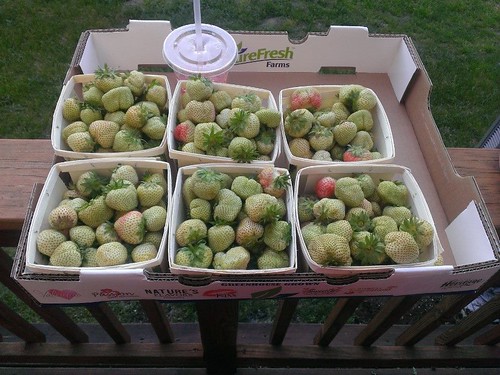
Green strawberries aren't a new breed of strawberry like pineberries, they're exactly what they sound like: unripe strawberries. You see them once in a while at some farmers markets, but they're not nearly as common as green tomatoes or chiles - I had to make arrangements with Kimballs to have them picked for me.
The green is really attractive - a sort of ivory green before it starts to yellow as it ripens to red - though that color does not survive cooking the way the deep red of ripe strawberries does. This ivory color is actually a sort of intermediate stage - if you're picking your own, let the strawberries grow a bit to reach this stage rather than picking the fruit as soon as it appears. Those earlier green-green or "unripe unripe" as opposed to "ripe unripe" strawberries are harder with less flavor.
Why use green strawberries? Purely as a change of pace and to better understand the strawberry. It's not like with tomatoes, where cooking green tomatoes is a good way to deal with the glut of red tomatoes you would otherwise have, or a way to use those tomatoes you get at the end of the season that won't have time to ripen.
However, there are some similarities to green tomatoes, mainly that, compared to ripe strawberries, green strawberries are firmer and more tart. The strawberry flavor is still there, just fainter and without the sugar to bring it out. There's another flavor too, which I guess is the flavor of the chlorophyll or whatever's making them green, a flavor that goes away when the strawberry ripens.
So what do we do with these.
The first thing I did was macerate some overnight with some sugar to make preserves - same basic method I use for ripe strawberries: macerate overnight, heat up until they just start to soften, turn off heat, let sit overnight, add more sugar and boil until jam-thick.

The ivory green is gone. The syrup of the jam is a color somewhere between golden raisins and cream soda, and the chunks of fruit show up in colors the paint swatch people might call Sun Belt Peach, Burnt Mountain Dew, and Foreclosed Lawn. It's a tart jam, but it's also surprisingly complex in flavor - far more than green tomatoes can yield, for instance, another difference there.
I've got more green strawberries in a jar of whiskey to make green strawberry bounce, some mixed with rhubarb for a pie, and some macerating in sugar to make green strawberry shrub. Tonight we'll have sliced raw green strawberries in salad and see how that goes.
Friday, June 6, 2014
farmstands 6-6-14
Finally the produce season is getting going. We've got our garden set up - tomatoes, fennel, and greens are doing great, lime basil mysteriously died, lovage and lavendar and sorrels (red and green) are doing pretty well. I just transplanted a Cuban oregano plant that the jury's still out on.
Rhubarb has come and will soon be gone at my mother's. By far the best thing I've done with it is this cake. Yes it has Jello. Yes it has marshmallows. It is fantastic.
The first local vegetables are starting to show up: radishes at Lull's today, green onions and broccoli raab (so much younger and sweeter than supermarket raab!) at Kimballs last weekend, and Caitlin picked up microgreens and white Japanese turnips (hakurei?) at the Copley Square Farmers Market today. I haven't tried those yet because she's actually not home yet, but turnips are wildly underrated, and I'm intrigued at trying a new-to-me variety.
This is also a good time of year for us (and anyone in this part of New England) to keep an eye on Valicenti Organico, a local (six minutes away from me) producer of pastas and sauces. We buy their ravioli regularly, which leans heavily on local fruits and vegetables. The ratatouille ravioli is one of my favorites, but at the moment we have two that we haven't tried yet: artichoke and boursin, and even more excitingly, pea tendril with grilled ramps and local mushrooms, which is three of my favorite vegetables in one ravioli.
It'll be another couple weeks before strawberries - I've requested some green strawberries from Kimballs in the meantime - and a few weeks after that before blueberries and early season vegetables. Tomatoes, forget it, not for ages.
Rhubarb has come and will soon be gone at my mother's. By far the best thing I've done with it is this cake. Yes it has Jello. Yes it has marshmallows. It is fantastic.
The first local vegetables are starting to show up: radishes at Lull's today, green onions and broccoli raab (so much younger and sweeter than supermarket raab!) at Kimballs last weekend, and Caitlin picked up microgreens and white Japanese turnips (hakurei?) at the Copley Square Farmers Market today. I haven't tried those yet because she's actually not home yet, but turnips are wildly underrated, and I'm intrigued at trying a new-to-me variety.
This is also a good time of year for us (and anyone in this part of New England) to keep an eye on Valicenti Organico, a local (six minutes away from me) producer of pastas and sauces. We buy their ravioli regularly, which leans heavily on local fruits and vegetables. The ratatouille ravioli is one of my favorites, but at the moment we have two that we haven't tried yet: artichoke and boursin, and even more excitingly, pea tendril with grilled ramps and local mushrooms, which is three of my favorite vegetables in one ravioli.
It'll be another couple weeks before strawberries - I've requested some green strawberries from Kimballs in the meantime - and a few weeks after that before blueberries and early season vegetables. Tomatoes, forget it, not for ages.
chicken riggins
I was aware of, but had never had, chicken riggies - an upstate New York dish of chicken and rigatoni with a creamy tomato-pepper sauce. But I added some sausage to mine and named it after Caitlin's favorite football player. Very good stuff, very flavorful, and made good leftovers for lunches.
Chicken Riggins

1 can (28 oz) San Marzano tomatoes. San Marzano tomatoes are rich, low-acid plum tomatoes, which are perfectly-suited to long-cooked red sauces like this one.
2 red bell peppers, stem/ribs/seeds removed.
3 cloves garlic.
1 small onion, chopped.
1 tablespoon sriracha or similar hot sauce (no vinegar, no lemon, no cumin)
1/4 cup dry vermouth
1/2 cup heavy cream
salt and herbs to taste - marjoram, oregano, fennel
4 chicken thighs, just the meat, chopped. You can often buy boneless skinless chicken thighs, but I would get the bone-in skin-on kind and make stock with what you don't use.
4 green onion sausages
rigatoni
fresh parmesan, grated, and green onions, sliced. We both agreed that using the good parm made a noticeable difference here.
Simmer the tomatoes, bell peppers, garlic, onion, sriracha, and dry vermouth together, covered, until the vegetables are very soft; blitz with immersion blender, cook down uncovered, slowly, until thick; add cream and seasonings, cook another half hour, and adjust seasonings if needed.
Meanwhile, toss the chopped chicken with a little Tony Chachere's seasoning salt and saute until cooked. Cook sausage links and slice. Drain fat if necessary and add meats to sauce.
Cook the rigatoni, finishing it in the red sauce the last 2 minutes, and serve with parmesan and green onions.
Chicken Riggins

1 can (28 oz) San Marzano tomatoes. San Marzano tomatoes are rich, low-acid plum tomatoes, which are perfectly-suited to long-cooked red sauces like this one.
2 red bell peppers, stem/ribs/seeds removed.
3 cloves garlic.
1 small onion, chopped.
1 tablespoon sriracha or similar hot sauce (no vinegar, no lemon, no cumin)
1/4 cup dry vermouth
1/2 cup heavy cream
salt and herbs to taste - marjoram, oregano, fennel
4 chicken thighs, just the meat, chopped. You can often buy boneless skinless chicken thighs, but I would get the bone-in skin-on kind and make stock with what you don't use.
4 green onion sausages
rigatoni
fresh parmesan, grated, and green onions, sliced. We both agreed that using the good parm made a noticeable difference here.
Simmer the tomatoes, bell peppers, garlic, onion, sriracha, and dry vermouth together, covered, until the vegetables are very soft; blitz with immersion blender, cook down uncovered, slowly, until thick; add cream and seasonings, cook another half hour, and adjust seasonings if needed.
Meanwhile, toss the chopped chicken with a little Tony Chachere's seasoning salt and saute until cooked. Cook sausage links and slice. Drain fat if necessary and add meats to sauce.
Cook the rigatoni, finishing it in the red sauce the last 2 minutes, and serve with parmesan and green onions.
Friday, May 9, 2014
what we blog about when we blog about butter
I keep saying "I need to blog about this, I need to blog about that," and never getting around to it, so here are some half-formed thoughts on butter that I haven't had a chance to follow through on yet:
THOUGHT 1: A couple weeks, maybe a couple months ago, I read about a chef who had made butter by combining cream with a soft ripened cheese (Camembert maybe?) in a 9:1 ratio, let the cream culture, and then churned it. I don't know exactly how Camemberty (maybe?) the butter came out, or if the cheese is just used as the source of the culture to culture the cream, BUT. It got me thinking about ways to manipulate cream before you churn it.
I've made butter before. I first started buying good dairy when I moved to Indiana and the farmers' markets (and many local stores) carried it, about 11 years ago now (geez). Good pasteurized cream makes decent butter and is a good exercise; cultured cream (adding a little buttermilk and letting it sit at room temp overnight) makes even better butter, though pasteurization does make it a little resistant to culturing. Anyway, if you have an immersion blender, making butter is as simple as whipping cream and continuing to whip it until it breaks into solid butter and liquid whey. If you don't have an immersion blender, well, it's still that simple, your arm will just be more tired.
So when thinking about ways to manipulate cream pre-butter, there are two limits you have to impose:
1a: The cream still has to be able to be turned into butter. That means you can't do anything that'll curdle it, like adding lemon juice, and you can't dilute the fat content (you can whip milk all day and you won't get butter, just warm milk). Does it mean you can add a liquid as long as you keep the fat percentage the same, such as by adding bacon fat? I don't THINK so, but I don't know for sure. If you add another fat, will it end up as part of the butter or leak out with the whey? I don't know that either.
1b: There is no point in manipulating the cream towards a different butter if you can get the same results by manipulating the butter. For instance: you can add cinnamon to cream and whip it into butter, but it won't be different from, or better than, adding cinnamon directly to butter. This is particularly key when you're forced to use pasteurized cream, because it means the best storebought butter is better than your homemade butter, so the best manipulated butter will only result from manipulated cream when manipulating the cream is the only way to reach the final product in question.
I think there are three basic forms of cream manipulation to be considered and explored: adding an ingredient (cheese, for instance), infusing the cream with an ingredient that is steeped and then removed (bay leaves, for instance), and changing the cream by other means (such as by smoking it or culturing it).
I thought about ramp butter made from ramp-infused cream, which invokes the 1b issue: will this be different from ramp butter made with ramps added directly to butter? Yes. Will it be significantly different? I don't know. Will it be better? I don't know. Even moreso that garlic, ramp mellows out when it cooks. We could be talking about something surprisingly subtle here.
THOUGHT 2:
This led to a consideration of fat manipulation and the manipulation of fats used in cooking.
I've made root beer flavored butter before, using Root from Art in the Age. It was made via fat-washing, wherein you add a fat to an alcohol, give it some time, and they trade flavors, because everything alcohol-soluble is also fat-soluble and vice versa. So, if you want butter-flavored Scotch, you end up with both that and Scotch-flavored butter. This naturally invites questions about what to do with the yin once you've created the yang you were looking for.
Thinking about ramp butter got me thinking about using fat washing to flavor butters rather than liquors, such as butter that's been fat-washed in Angostura bitters to make bitters butter to put on, for instance, cinnamon toast (or hamburgers or corn on the cob or who knows!) How bitter would the butter be? Would it take up all the flavors of the Ango equally, or would they wind up in a slightly different mix? This needs to be played with.
That led to thinking about other fats that could be flavored with liquor, and other ways of using them. The flavored butters are condiments, but what if we flavored a fat that we cook with? If we made bourbon-flavored lard, could we fry chicken in it, or would the heat (which is half again as hot as your hot toddy) destroy the bourbon flavors? If it didn't destroy the bourbon flavors, how much would those flavors flavor the chicken, and how would the final product differ from chicken marinated in bourbon?
Bourbon fried chicken is the obvious killer app here, but that's just my brick road, that's where my feet go, there are other places to check out too.
What about vermouth-infused olive oil?
What about making biscuits, pie crust, or pastry dough with an alcohol-flavored fat?
And so on.
Much to do, clearly.
THOUGHT 1: A couple weeks, maybe a couple months ago, I read about a chef who had made butter by combining cream with a soft ripened cheese (Camembert maybe?) in a 9:1 ratio, let the cream culture, and then churned it. I don't know exactly how Camemberty (maybe?) the butter came out, or if the cheese is just used as the source of the culture to culture the cream, BUT. It got me thinking about ways to manipulate cream before you churn it.
I've made butter before. I first started buying good dairy when I moved to Indiana and the farmers' markets (and many local stores) carried it, about 11 years ago now (geez). Good pasteurized cream makes decent butter and is a good exercise; cultured cream (adding a little buttermilk and letting it sit at room temp overnight) makes even better butter, though pasteurization does make it a little resistant to culturing. Anyway, if you have an immersion blender, making butter is as simple as whipping cream and continuing to whip it until it breaks into solid butter and liquid whey. If you don't have an immersion blender, well, it's still that simple, your arm will just be more tired.
So when thinking about ways to manipulate cream pre-butter, there are two limits you have to impose:
1a: The cream still has to be able to be turned into butter. That means you can't do anything that'll curdle it, like adding lemon juice, and you can't dilute the fat content (you can whip milk all day and you won't get butter, just warm milk). Does it mean you can add a liquid as long as you keep the fat percentage the same, such as by adding bacon fat? I don't THINK so, but I don't know for sure. If you add another fat, will it end up as part of the butter or leak out with the whey? I don't know that either.
1b: There is no point in manipulating the cream towards a different butter if you can get the same results by manipulating the butter. For instance: you can add cinnamon to cream and whip it into butter, but it won't be different from, or better than, adding cinnamon directly to butter. This is particularly key when you're forced to use pasteurized cream, because it means the best storebought butter is better than your homemade butter, so the best manipulated butter will only result from manipulated cream when manipulating the cream is the only way to reach the final product in question.
I think there are three basic forms of cream manipulation to be considered and explored: adding an ingredient (cheese, for instance), infusing the cream with an ingredient that is steeped and then removed (bay leaves, for instance), and changing the cream by other means (such as by smoking it or culturing it).
I thought about ramp butter made from ramp-infused cream, which invokes the 1b issue: will this be different from ramp butter made with ramps added directly to butter? Yes. Will it be significantly different? I don't know. Will it be better? I don't know. Even moreso that garlic, ramp mellows out when it cooks. We could be talking about something surprisingly subtle here.
THOUGHT 2:
This led to a consideration of fat manipulation and the manipulation of fats used in cooking.
I've made root beer flavored butter before, using Root from Art in the Age. It was made via fat-washing, wherein you add a fat to an alcohol, give it some time, and they trade flavors, because everything alcohol-soluble is also fat-soluble and vice versa. So, if you want butter-flavored Scotch, you end up with both that and Scotch-flavored butter. This naturally invites questions about what to do with the yin once you've created the yang you were looking for.
Thinking about ramp butter got me thinking about using fat washing to flavor butters rather than liquors, such as butter that's been fat-washed in Angostura bitters to make bitters butter to put on, for instance, cinnamon toast (or hamburgers or corn on the cob or who knows!) How bitter would the butter be? Would it take up all the flavors of the Ango equally, or would they wind up in a slightly different mix? This needs to be played with.
That led to thinking about other fats that could be flavored with liquor, and other ways of using them. The flavored butters are condiments, but what if we flavored a fat that we cook with? If we made bourbon-flavored lard, could we fry chicken in it, or would the heat (which is half again as hot as your hot toddy) destroy the bourbon flavors? If it didn't destroy the bourbon flavors, how much would those flavors flavor the chicken, and how would the final product differ from chicken marinated in bourbon?
Bourbon fried chicken is the obvious killer app here, but that's just my brick road, that's where my feet go, there are other places to check out too.
What about vermouth-infused olive oil?
What about making biscuits, pie crust, or pastry dough with an alcohol-flavored fat?
And so on.
Much to do, clearly.
Wednesday, April 2, 2014
meat days
One day a week, more or less, the Lenten fast goes on hold. I'm not doing it for religious reasons, so for me that day's not always Sunday. Some meat highlights:
Rendang poboys:
I had ordered live crawfish to boil, and while I was at it, had them throw in some poboy bread since the shipping charge was the same either way. I haven't had real poboy bread in ten years, man. It makes a difference.
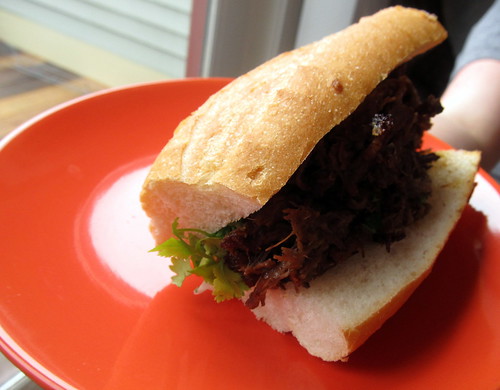
The idea here was to do something like New Orleans' roast beef poboys - wherein a chuck roast is braised until it's falling apart, and served on the sandwich complete with its thick flavorful gravy - but to nudge the flavors in a different direction.
I braised a 4 pound chuck roast (after browning in coconut oil) for about 3 hours in one can of coconut milk, a full tube of lemongrass paste (six stalks' worth of lemongrass, according to the label - lemongrass is such a pain in the ass that I have no qualms using the convenience version), a squirt of sriracha, and a paste made of two shallots, six cloves of garlic, about a cubic inch of fresh ginger. Seasoned everything with a little cumin, a little ground coriander, a little ground nutmeg, and fish sauce to taste (rather than salt). Once the beef was falling apart, I removed it, let the sauce continue to cook down until it started to sputter as the coconut oil started to break out, shredded the beef, and added it back in to coat it and slightly fry it.
Served it on the rolls with chopped cilantro, shallots, and mint. Fresh tomato wouldn't be out of the question.
Chaurice-celeriac tomato sauce.
I'm a sucker for pasta sauces that use both tomato and seafood stock, but the thing is, I'm not a big fan of the ones with a ton of seafood in them. I like the seafood stock to provide a backbone. You could certainly add clams, crawfish, or shrimp to this, but it's much more subtle and interesting without them. Chaurice is a Louisiana sausage that comes both fresh and smoked and gets its heat from jalapeno, with a little vinegar. Do not be fooled by the similarity in name to chorizo or chourico - they are not the same. Hot Italian sausage wouldn't be the same either, but it'd be good, and it's easier to find.
Brown about six ounces of fresh chaurice (bulk, or removed from link casings) with some sliced onion or shallot. Add half a cup of peeled diced celery root (celeriac) and a couple cloves of smashed garlic, and a can of tomatoes, pureed (the smaller ones, not the 28 oz). Add a couple cups of crawfish stock (crawfish shells covered in water and simmered for an hour, then strained) - the sauce should be way too thin at this point. Cook it down until it isn't - 3, 4 hours. Add a spoonful or two of vermouth and check for salt, though there's a good chance you won't need it, between the sausage and the crawfish stock.
The flavor profile here is kinda like a Bloody Mary, kinda like Old Bay. I served it on strozzapreti.

Rendang poboys:
I had ordered live crawfish to boil, and while I was at it, had them throw in some poboy bread since the shipping charge was the same either way. I haven't had real poboy bread in ten years, man. It makes a difference.

The idea here was to do something like New Orleans' roast beef poboys - wherein a chuck roast is braised until it's falling apart, and served on the sandwich complete with its thick flavorful gravy - but to nudge the flavors in a different direction.
I braised a 4 pound chuck roast (after browning in coconut oil) for about 3 hours in one can of coconut milk, a full tube of lemongrass paste (six stalks' worth of lemongrass, according to the label - lemongrass is such a pain in the ass that I have no qualms using the convenience version), a squirt of sriracha, and a paste made of two shallots, six cloves of garlic, about a cubic inch of fresh ginger. Seasoned everything with a little cumin, a little ground coriander, a little ground nutmeg, and fish sauce to taste (rather than salt). Once the beef was falling apart, I removed it, let the sauce continue to cook down until it started to sputter as the coconut oil started to break out, shredded the beef, and added it back in to coat it and slightly fry it.
Served it on the rolls with chopped cilantro, shallots, and mint. Fresh tomato wouldn't be out of the question.
Chaurice-celeriac tomato sauce.
I'm a sucker for pasta sauces that use both tomato and seafood stock, but the thing is, I'm not a big fan of the ones with a ton of seafood in them. I like the seafood stock to provide a backbone. You could certainly add clams, crawfish, or shrimp to this, but it's much more subtle and interesting without them. Chaurice is a Louisiana sausage that comes both fresh and smoked and gets its heat from jalapeno, with a little vinegar. Do not be fooled by the similarity in name to chorizo or chourico - they are not the same. Hot Italian sausage wouldn't be the same either, but it'd be good, and it's easier to find.
Brown about six ounces of fresh chaurice (bulk, or removed from link casings) with some sliced onion or shallot. Add half a cup of peeled diced celery root (celeriac) and a couple cloves of smashed garlic, and a can of tomatoes, pureed (the smaller ones, not the 28 oz). Add a couple cups of crawfish stock (crawfish shells covered in water and simmered for an hour, then strained) - the sauce should be way too thin at this point. Cook it down until it isn't - 3, 4 hours. Add a spoonful or two of vermouth and check for salt, though there's a good chance you won't need it, between the sausage and the crawfish stock.
The flavor profile here is kinda like a Bloody Mary, kinda like Old Bay. I served it on strozzapreti.

Monday, March 17, 2014
eastern standard and the hawthorne
A couple weeks ago, Caitlin and I took a "freelancer's weekend" - Wednesday through Friday - in Boston, to do some of the things we'd meant to do and never got around to when she actually lived there, like the Aquarium (disappointing compared to New Orleans) and the MFA (fantastic). Blog-relevant: our lunch at Eastern Standard and drinks at the Hawthorne, both of which are located in our hotel, the Hotel Commonwealth.
Eastern Standard was crowded as shit, and our first attempt to eat there failed - we were tired and hungry, the place was packed, it was freezing cold, and there was a half hour wait. We tried again for lunch the next day - still packed, but there was a free table.

We started with the cheese plate, and I have an awful memory for cheese plates and always wish they came with a card to remind you what you've eaten. The sheep's milk and semisoft cheeses on the left and middle were great; the blue, well, I was able to finish it, but ought to remember to specify "no blue" when I order cheese plates.

The chocolate-cardamom egg cream Caitlin ordered was a highlight of the weekend, but my rum drink - Guayaba Arabica, Naomi Levy's award-winning combination of rum, guava nectar, coffee syrup, lime juice, and cilantro - was terrific too.

Our appetizer was small - my only complaint - but maybe the single best bite of food we had all weekend: cubes of pork belly paired with garlicky escargots, some kind of herb puree, and very tart pickled mushrooms. It was Caitlin's first encounter with escargots and my best - I've only had them on their own before, but paired with rich pork they were even better.
I did the "two apps as an entree" thing and went all-raw: oysters and steak tartare.


Both were great - the steak tartare was just right, the right temperature, seasoned just enough, not too busy. It's easy to get steak tartare wrong, especially these days when it's fallen out of favor.
Caitlin had the moules provencal, which were nice and fennelly.

We went to the Hawthorne twice - once for late-night drinks our first night there, and then just after opening the next night, for drinks and "a dinner of snacks." We were waited on mainly by Amanda (both nights), but also talked to, and were brought drinks by, bar manager Jackson Cannon.


The Hawthorne serves mainly small plates, as you can see. It's a great space - really comfortable and low key, with great people. They treated us very well, and comped us some of our food and two drinks both nights. Not pictured are the pretzel nuggets we had with beer mustard, after our initial deviled eggs and mixed pickle plate:

That's pickled brussels sprouts, pickled cranberries, pickled mushrooms, pickled chickpeas, and I think I'm forgetting something. Turnip or something?
There's no way I'll remember what order we had our drinks in:

Mine. The Naked and Famous: mezcal, Aperol, chartreuse, lime. I have so much trouble mixing with mezcal myself, and Caitlin isn't a fan of it or tequila so I've stopped putting much work into it, but this was great.

Mine. Hanky Panky (gin, Fernet, vermouth). A classic, well-executed.

Mine. They had a lot of amari I hadn't tried and can't buy in New Hampshire, so I decided to try one of them, Nardini, with soda water.

Rum drinks. Caitlin's on the left - a Marshall Islands swizzle, with rum, ginger, honey, and lime juice. They really know what they're doing with ginger at the Hawthorne - that informed one of my later choices. My drink here was a special request - "something bitter with coffee liqueur in it." I think they used Campari, but I don't remember for sure.

The Improved Bamboo cocktail, one of our comped drinks they thought we'd like. Sherry, dry vermouth, and sweet vermouth. My first sherry cocktail, and it was fantastic - one of the best drinks we had.

Special request by Caitlin: something with the framboise eau de vie they listed in the menu. I suggested a basic sour - they went the extra mile by incorporating egg white. It focused the raspberry flavor perfectly.

Mine. "Something with ginger and Campari." I don't know what else ended up in there, but it's so good.

Mine. The Fino Swizzle - cognac, port, cherry syrup, lemon juice, sherry, and bitters. So so good. How are the sherry drinks the best drinks? Why haven't I been paying attention to sherry drinks?
I apparently didn't get a photo of Caitlin's Phil Collins, but it was really good - cucumber vodka, lime juice, simple, and chartreuse, topped with soda. Could drink those all summer.
Since it's St Patricks Day, I ought to also mention Irish whiskey! I haven't got a photo of it, but I recently picked up a bottle of Tullamore Dew Phoenix, and it's a fantastic whiskey - my favorite new whiskey in years, incredibly smooth given the 110 proof.
Eastern Standard was crowded as shit, and our first attempt to eat there failed - we were tired and hungry, the place was packed, it was freezing cold, and there was a half hour wait. We tried again for lunch the next day - still packed, but there was a free table.

We started with the cheese plate, and I have an awful memory for cheese plates and always wish they came with a card to remind you what you've eaten. The sheep's milk and semisoft cheeses on the left and middle were great; the blue, well, I was able to finish it, but ought to remember to specify "no blue" when I order cheese plates.

The chocolate-cardamom egg cream Caitlin ordered was a highlight of the weekend, but my rum drink - Guayaba Arabica, Naomi Levy's award-winning combination of rum, guava nectar, coffee syrup, lime juice, and cilantro - was terrific too.

Our appetizer was small - my only complaint - but maybe the single best bite of food we had all weekend: cubes of pork belly paired with garlicky escargots, some kind of herb puree, and very tart pickled mushrooms. It was Caitlin's first encounter with escargots and my best - I've only had them on their own before, but paired with rich pork they were even better.
I did the "two apps as an entree" thing and went all-raw: oysters and steak tartare.


Both were great - the steak tartare was just right, the right temperature, seasoned just enough, not too busy. It's easy to get steak tartare wrong, especially these days when it's fallen out of favor.
Caitlin had the moules provencal, which were nice and fennelly.

We went to the Hawthorne twice - once for late-night drinks our first night there, and then just after opening the next night, for drinks and "a dinner of snacks." We were waited on mainly by Amanda (both nights), but also talked to, and were brought drinks by, bar manager Jackson Cannon.


The Hawthorne serves mainly small plates, as you can see. It's a great space - really comfortable and low key, with great people. They treated us very well, and comped us some of our food and two drinks both nights. Not pictured are the pretzel nuggets we had with beer mustard, after our initial deviled eggs and mixed pickle plate:

That's pickled brussels sprouts, pickled cranberries, pickled mushrooms, pickled chickpeas, and I think I'm forgetting something. Turnip or something?
There's no way I'll remember what order we had our drinks in:

Mine. The Naked and Famous: mezcal, Aperol, chartreuse, lime. I have so much trouble mixing with mezcal myself, and Caitlin isn't a fan of it or tequila so I've stopped putting much work into it, but this was great.

Mine. Hanky Panky (gin, Fernet, vermouth). A classic, well-executed.

Mine. They had a lot of amari I hadn't tried and can't buy in New Hampshire, so I decided to try one of them, Nardini, with soda water.

Rum drinks. Caitlin's on the left - a Marshall Islands swizzle, with rum, ginger, honey, and lime juice. They really know what they're doing with ginger at the Hawthorne - that informed one of my later choices. My drink here was a special request - "something bitter with coffee liqueur in it." I think they used Campari, but I don't remember for sure.

The Improved Bamboo cocktail, one of our comped drinks they thought we'd like. Sherry, dry vermouth, and sweet vermouth. My first sherry cocktail, and it was fantastic - one of the best drinks we had.

Special request by Caitlin: something with the framboise eau de vie they listed in the menu. I suggested a basic sour - they went the extra mile by incorporating egg white. It focused the raspberry flavor perfectly.

Mine. "Something with ginger and Campari." I don't know what else ended up in there, but it's so good.

Mine. The Fino Swizzle - cognac, port, cherry syrup, lemon juice, sherry, and bitters. So so good. How are the sherry drinks the best drinks? Why haven't I been paying attention to sherry drinks?
I apparently didn't get a photo of Caitlin's Phil Collins, but it was really good - cucumber vodka, lime juice, simple, and chartreuse, topped with soda. Could drink those all summer.
Since it's St Patricks Day, I ought to also mention Irish whiskey! I haven't got a photo of it, but I recently picked up a bottle of Tullamore Dew Phoenix, and it's a fantastic whiskey - my favorite new whiskey in years, incredibly smooth given the 110 proof.
Thursday, February 20, 2014
smothered duck and cabbage
This is my eighth winter back in New England, unfortunately, and one of the things I always said was that usually the way winter works here is, if it's super-cold, at least you don't get as much snow; if it's super-snowy, at least it's not as cold. I swear it was a good rule of thumb - there's such a thing as too cold to snow, after all, and New Hampshire gets that cold without much work. But this year, this year decided to prove me wrong - the National Weather Service said today that NH had both a snowier winter than average and a colder one.
Welllll fuck that.
I know it's almost the end of February, but there is a mountain of snow outside, we've had four noteworthy storms in the last, what, week and a half, I've been rear-ended by a car that was slipping and sliding on the snow and couldn't stop in time, I've driven through town half-blind because ice was forming on the windshield faster than the wipers could remove it, and those wipers are themselves now shredded to pieces as a result.
So we made some winter food. Some really really wintry food. Stick to your ribs.

The principle of smothering anything is really simple: you cook it with just enough liquid to keep it from sticking, until it's very tender. It's a fine line between smothered X and braised X or X stew, but if I hear "braised," I think more added liquid than "smothered," and if I hear "stew," I think "thickened," whether by a roux, cream, or the starch from added ingredients.
In this case, this is smothered duck and cabbage, which takes a little more doing than usual: I started with a whole duck, cut it into pieces, and because this is a domestic duck, it has a hell of a lot of fat on it. Cutting slits in the skin, sprinkling salt on, patting dry, waiting a couple hours and patting dry again, and then browning every piece resulted in cooking off a full pint of duck fat, before continuing on.
In the meantime, I chopped up a red cabbage, sprinkled it with salt and left it in a colander, and rinsed the salt off after the duck was done. Just helps it cook by getting some of the water out.
Everything else? One bunch of young carrots, the kind sold with tops on. One onion, halved and sliced. A handful of celery leaves, sliced up. Chicken-duck-garlic stock, made with chicken thigh bones, chicken wing tips, garlic cloves, and the duck neck - just stuff I happened to have left over. Some hot sauce. Plenty of salt.
Browning the duck is very important, and then the duck is removed to a platter, the fat is removed, the vegetables are briefly sauteed in the same pan, and the duck and veggies go into a cast iron Dutch oven in layers. Barely fit.
A couple hours in the oven at 350 and boom, all set.
Welllll fuck that.
I know it's almost the end of February, but there is a mountain of snow outside, we've had four noteworthy storms in the last, what, week and a half, I've been rear-ended by a car that was slipping and sliding on the snow and couldn't stop in time, I've driven through town half-blind because ice was forming on the windshield faster than the wipers could remove it, and those wipers are themselves now shredded to pieces as a result.
So we made some winter food. Some really really wintry food. Stick to your ribs.

The principle of smothering anything is really simple: you cook it with just enough liquid to keep it from sticking, until it's very tender. It's a fine line between smothered X and braised X or X stew, but if I hear "braised," I think more added liquid than "smothered," and if I hear "stew," I think "thickened," whether by a roux, cream, or the starch from added ingredients.
In this case, this is smothered duck and cabbage, which takes a little more doing than usual: I started with a whole duck, cut it into pieces, and because this is a domestic duck, it has a hell of a lot of fat on it. Cutting slits in the skin, sprinkling salt on, patting dry, waiting a couple hours and patting dry again, and then browning every piece resulted in cooking off a full pint of duck fat, before continuing on.
In the meantime, I chopped up a red cabbage, sprinkled it with salt and left it in a colander, and rinsed the salt off after the duck was done. Just helps it cook by getting some of the water out.
Everything else? One bunch of young carrots, the kind sold with tops on. One onion, halved and sliced. A handful of celery leaves, sliced up. Chicken-duck-garlic stock, made with chicken thigh bones, chicken wing tips, garlic cloves, and the duck neck - just stuff I happened to have left over. Some hot sauce. Plenty of salt.
Browning the duck is very important, and then the duck is removed to a platter, the fat is removed, the vegetables are briefly sauteed in the same pan, and the duck and veggies go into a cast iron Dutch oven in layers. Barely fit.
A couple hours in the oven at 350 and boom, all set.
Thursday, January 30, 2014
so much catching up
Geez, I am getting so bad at keeping up with this. Let's start at least by covering a few meals I've made lately, or lately-ish:
Squash-pecan soup with grilled cheese.

This is a pretty frequent lunch for us: grilled cheese and some kind of smooth soup. Obviously tomato soup is the best option, in season, but in these stupid cold months, nothing doing. I went with something nuttier here: I simmered together peeled/seeded butternut squash, kabocha, garlic, onion, and pecan butter, with just enough water, a little sriracha, and enough red miso to add sufficient salt, and once the squashes were soft, blended it all up. I also added some chopped enoki mushrooms because we've been in a mushroom mood lately - which also explains the dab of black truffle butter I served it with.
Barramundi with succotash and radish-parsnip salad.
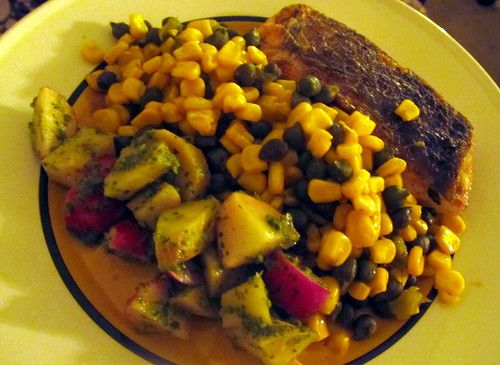
The color's no good on this photo, I know. I had picked up a bunch of fish at Trader Joes - their frozen fish is pretty reliable in quality, so I stock up sometimes so that I've always got some decent fish on hand - and though I'd never had succotash with fish, apparently it's a traditional pairing. Those two elements here are very basic: the fish fillets were cooked for five minutes on each side in butter with Tony Chachere's, and then rested while the succotash finished; the succotash is frozen sweet corn (Trader Joe's again, in fact) with green chiles, salt, butter, and cooked "fresh" (frozen) chickpeas, which took quite a lot longer than I expected to cook (nearly 20 minutes).
The radish and parsnip salad is worth talking about. The parsnips are sort of parboiled - I peeled and chopped them and then simmered them in salted water, but only for about ten minutes. That's not enough to make them soft - it just softened them so they were closer in texture to raw radishes. Normally I would toss the parcooked parsnip, still warm, with everything else - in this case everything was made ahead of time, so I heated the radish-parsnip salad in the microwave just enough that it wouldn't be fridge-cold.
The other elements of that salad are raw chopped radishes and a dressing made from the cleaned radish greens, culantro, roasted green chiles, olive oil, salt, and just a little lemon juice, pureed. Toss the radishes and parsnips with the dressing and let sit for a bit. It's not quite a salad, not quite a salsa.
Fried chicken sandwich.
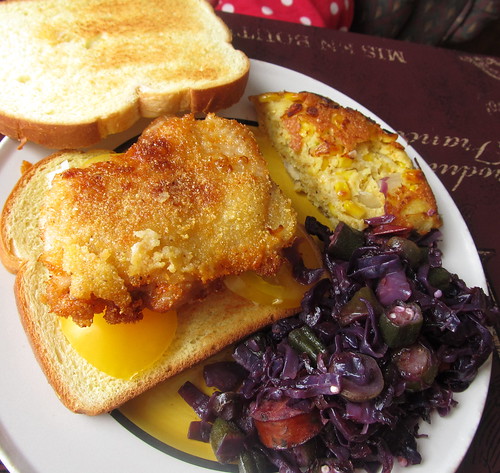
Another standard! The chicken is skin-on boneless chicken thigh, with cherry tomato and onion on the sandwich (and Duke's mayo for me). The cornbread in the background is made with a lot of corn and onion.
The smothered cabbage and okra is one of my favorite things: chopped red cabbage, tossed with salt, squeezed, sat for an hour, and rinsed (this draws a lot of water out of the cabbage so it cooks more readily), before being cooked on low heat for a couple hours with onion, Tony Chachere's, cherry tomatoes, and sausage (smoked chaurice from Louisiana). The sliced okra was added in the last ten minutes of cooking or so, so that it still has some crispness.
Refried black-eyed peas.
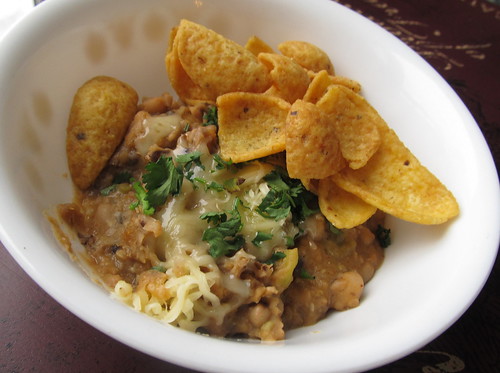
Man, I used to make refried beans all the time, and I'm not sure when I stopped.
Black-eyed peas are really well suited to this. It's as easy as you think: cook the beans until they're well-cooked, mash with a little of the liquid they cooked in, and add to hot lard. Season with onion or garlic you cooked in the lard, green chiles, cumin, anything like that. For me, if nothing else, you at least want sufficient salt, a noticeable amount of cumin, and a noticeable hit of spice heat (in this case from green chiles). Serve, in this case, with cheese, cilantro, and Fritos.
Squash-pecan soup with grilled cheese.

This is a pretty frequent lunch for us: grilled cheese and some kind of smooth soup. Obviously tomato soup is the best option, in season, but in these stupid cold months, nothing doing. I went with something nuttier here: I simmered together peeled/seeded butternut squash, kabocha, garlic, onion, and pecan butter, with just enough water, a little sriracha, and enough red miso to add sufficient salt, and once the squashes were soft, blended it all up. I also added some chopped enoki mushrooms because we've been in a mushroom mood lately - which also explains the dab of black truffle butter I served it with.
Barramundi with succotash and radish-parsnip salad.

The color's no good on this photo, I know. I had picked up a bunch of fish at Trader Joes - their frozen fish is pretty reliable in quality, so I stock up sometimes so that I've always got some decent fish on hand - and though I'd never had succotash with fish, apparently it's a traditional pairing. Those two elements here are very basic: the fish fillets were cooked for five minutes on each side in butter with Tony Chachere's, and then rested while the succotash finished; the succotash is frozen sweet corn (Trader Joe's again, in fact) with green chiles, salt, butter, and cooked "fresh" (frozen) chickpeas, which took quite a lot longer than I expected to cook (nearly 20 minutes).
The radish and parsnip salad is worth talking about. The parsnips are sort of parboiled - I peeled and chopped them and then simmered them in salted water, but only for about ten minutes. That's not enough to make them soft - it just softened them so they were closer in texture to raw radishes. Normally I would toss the parcooked parsnip, still warm, with everything else - in this case everything was made ahead of time, so I heated the radish-parsnip salad in the microwave just enough that it wouldn't be fridge-cold.
The other elements of that salad are raw chopped radishes and a dressing made from the cleaned radish greens, culantro, roasted green chiles, olive oil, salt, and just a little lemon juice, pureed. Toss the radishes and parsnips with the dressing and let sit for a bit. It's not quite a salad, not quite a salsa.
Fried chicken sandwich.

Another standard! The chicken is skin-on boneless chicken thigh, with cherry tomato and onion on the sandwich (and Duke's mayo for me). The cornbread in the background is made with a lot of corn and onion.
The smothered cabbage and okra is one of my favorite things: chopped red cabbage, tossed with salt, squeezed, sat for an hour, and rinsed (this draws a lot of water out of the cabbage so it cooks more readily), before being cooked on low heat for a couple hours with onion, Tony Chachere's, cherry tomatoes, and sausage (smoked chaurice from Louisiana). The sliced okra was added in the last ten minutes of cooking or so, so that it still has some crispness.
Refried black-eyed peas.

Man, I used to make refried beans all the time, and I'm not sure when I stopped.
Black-eyed peas are really well suited to this. It's as easy as you think: cook the beans until they're well-cooked, mash with a little of the liquid they cooked in, and add to hot lard. Season with onion or garlic you cooked in the lard, green chiles, cumin, anything like that. For me, if nothing else, you at least want sufficient salt, a noticeable amount of cumin, and a noticeable hit of spice heat (in this case from green chiles). Serve, in this case, with cheese, cilantro, and Fritos.
Subscribe to:
Posts (Atom)